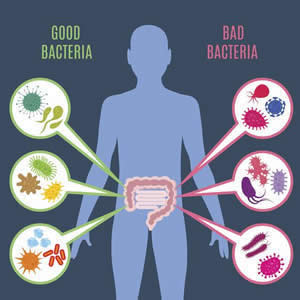
Fructose Malabsorption
Fructose is difficult to digest
What is fructose malabsorption?
Symptoms of fructose malabsorption
Causes of fructose malabsorption
Diagnosis of fructose malabsorption
Prevention / remedies / treatment for fructose malabsorption
Download free FODMAP / low fructose foods PDF brochure
References
Fructose is difficult to digest
Most people (yes, most people) get more fructose than their digestive system can absorb. Most people cannot properly digest all the fructose they get every day from an apparently normal and healthy diet. If you are eating large quantities of fruit thinking it's healthy, well think again. A normal healthy adult can properly digest 25-50 grams of fructose per day. Many people have difficulty digesting less than that, and a few have difficulty digesting any fructose at all.
Here are a couple of examples of the fructose content in some common high-fructose foods:
- Apple 35 grams per kilo.
- Asparagus 11 grams per kilo.
- Watermelon 23 grams per kilo.
- Can of soft drink (soda) 20-35 grams.
If you have a high-fructose diet, here are the consequences:
- If your digestive system is able to absorb all that fructose, you'll suffer from weight gain / obesity, liver cirrhosis, fatty liver and other symptoms of an abused liver that are normally found in those who drink excessive alcohol.
- If your digestive system cannot absorb all the fructose, you'll suffer from DIARRHOEA the fructose malabsorption symptoms described below.
What is fructose malabsorption?
Fructose malabsorption is a common digestive disorder in which absorption of fructose (or other sugars like lactose or sorbitol) in the small intestine is impaired. About 30-40% of people suffer from FM.
Fructose intolerance (as opposed to malabsorption) is a rare (1 in 10,000 people) and potentially fatal condition in which the liver enzymes that digest fructose are deficient. Fructose intolerance will not be further discussed in this article.
If you eat more fructose than your small intestine can absorb, the excess fructose passes through to the large intestine. In the large intestine, the fructose prevents the absorption of water. This causes watery stools / diarrhoea, and prevents absorption of minerals and vitamins. The abnormal sugar in the large intestine also feeds the bacteria and yeasts there, producing hydrogen, carbon dioxide and methane. These gases create pressure in the large intestine, causing bloating, abdominal pain and flatulence.
Symptoms of fructose malabsorption
The symptoms of fructose malabsorption have some similarities to those of irritable bowel syndrome (IBS), food allergies, food intolerance, and the inability to digest properly (weak digestion). These symptoms can also be caused by yeast sensitivity or candida, from which around 1 in 3 people suffer. Interestingly, candida is one of the consequences of FM
Immediate symptoms (within minutes of consumption, and up to 3 days)
- Flatulence. Floating, bulky, pale and smelly stools and excessive wind.
- Bloating and distension (from fermentation in the small and large intestine).
- Diarrhoea (or less commonly, constipation).
- Indigestion / stomach pain / abdominal pain.
- Fatigue / lack of energy / tiredness.
- Brain fog / negative emotions.
- Nausea or even vomiting if large quantities of fructose are consumed.
long-term symptoms
- Sugar craving (or less frequently, sugar aversion).
- Poor mineral and vitamin absorption causing anaemia, malnourishment and general poor health. Often B vitamins, folate, tryptophan, zinc, iron, magnesium, calcium and other vitamins and minerals will be low. Patients take supplements of these minerals and vitamins with little or no benefit, because they are not being absorbed. They eat good high-nutrient foods, but again many micronutrients in this food are not digested properly.
- Poor skin, nails and hair.
- Underweight, difficulty gaining weight (however, it is also possible to be overweight whilst suffering FM).
- Being moody, early signs of mental depression. (2)
- Osteopenia / osteoporosis, which can also be caused by a diet high in fructose and low in magnesium. (1)
- Blood triglyceride levels raised.
- Heart disease. (3)
- Inflammation in many forms (skin problems such as rashes, hives, eczema, Seborrheic dermatitis etc, IBS, heart disease).
- Eventually, chronic degenerative diseases and debility, without an obvious cause.
Causes of fructose malabsorption
- The number one cause is damage to your gut biome, usually from the use of antibiotics, but also from the modern processed food diet and excessive hygiene. Getting your gut biome sequenced is no longer a difficult and expensive task, you can get details of your gut biome imbalance with a simple test kit.
- Eating more sugar and other FODMAPs than your gut and liver can process.
- Leaky gut.
- Gluten allergy.
- Weak digestion.
- Worms or other gut parasites.
Diagnosis of fructose malabsorption
- Hydrogen breath test.
- Stool test.
- Self-diagnosis - keep a diary of all foods/drinks taken, and symptoms noticed. The journal is important, because the effects of some foods can take hours or even up to 3 days to start.
Prevention / remedies / treatment for fructose malabsorption
Doctors say there is no known cure for fructose malabsorption. However, I have seen many people healed of fructose malabsorption.
Dietary changes can eliminate all symptoms very quickly. Eat small meals of simple, easily digestible foods and avoid FODMAPs. This helps to restore normal digestion, and maintain subsequent health. While you are on the low FODMAP diet you MUST restore your gut biome with prebiotics and probiotics, this is the key. After you have been symptom-free for some months, you can gradually re-introduce small quantities of many of the foods that previously caused problems. It seems that being symptom-free for a long period allows fructose malabsorption to heal.
The main reason that you can digest FODMAP foods after a period of abstention is that you have re-established those microorganisms in your gut that digest FODMAPs. Fructose malabsorption is caused by disruption to the gut biome, usually from the use of antibiotics, but also from the modern processed food diet and excessive hygiene.

Get your gut microbiome sequenced
- buy a simple test kit
If you have a chronic case of fructose malabsorption, or you want to heal it quickly and permanently, a quick way to do it is with a faecal transplant. The benefits of re-populating your gut with healthy microorganisms are usually felt within hours.
I have found that the low FODMAP diet works extraordinarily well if you follow it precisely. However, it is so restrictive that you probably don't want to follow it for years, because it restricts so many fruits and vegetables that you will lack variety in your diet and may miss out on important nutrients.
Which foods to avoid
I have produced a simple three page brochure detailing the foods to avoid if you suffer from fructose malabsorption. It also lists foods that are safe for fructose malabsorption.
Firstly, it lists foods that contain a high level of free fructose. Glucose helps the small colon to absorb fructose. So if a food is high in fructose, but also contains as much or more glucose, you can usually eat it with no ill-effects. It also lists the foods that are high in fructans that usually cause the same problems.
If this does not solve the problem within a few weeks, you may need to follow the stricter low FODMAP guidance detailed on the next two pages. FODMAPs are Fermentable Oligosaccharides (eg: fructans, galactans), Disaccharides (eg: lactose), Monosaccharides (eg: fructose) and Polyols (eg: sorbitol, mannitol, maltitol, Xylitol, isomalt etc). These food molecules may cause the same food absorption problems as fructose. The brochure lists those foods that are high in FODMAPs. It also lists those foods that have low or no FODMAPs.
FREE Download FODMAP / low fructose foods brochure
References
1. Milne D, Nielsen F.
The interaction between dietary fructose and magnesium adversely affects macromineral homeostasis in men.
Journal of the American College of Nutrition. 2000;19(1):31-37
2. Ledochowski M, Widner B, Bair H, Probst T, Fuchs D.
Fructose and sorbitol-reduced diet improves mood and gastrointestinal disturbances in fructose malabsorbers.
Scandinavian Journal of Gastroenterologist. 2000;10:1048-52
3. Busserolles J, Gueux E, Rock E, Mazur A, Rayssiguier Y.
High fructose feeding of magnesium deficient rats is associated with increased plasma triglyceride concentration and increased
oxidative stress.
Magnesium Research. 2003;16(1):7-12
